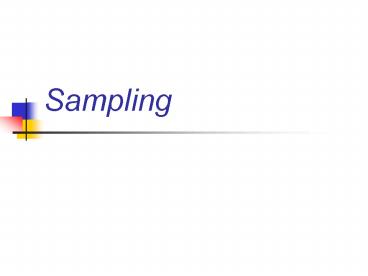Sampling - PowerPoint PPT Presentation
1 / 20
Title: Sampling
1
Sampling
2
Population
- A population is all the cases of interest.
- It is seldom possible to survey the whole
population. - Therefore, it is necessary to select a subset of
the population to represent the population as a
whole.
3
Sampling Frame
- The sampling frame is the specific list of
members of the population. - e.g. doctors listed on the HIC database.
- The sampling frame is an operational definition
of the population of interest.
4
Sample
- The sample is the subset drawn from the sampling
frame. - How closely the responses (e.g. attitudes,
behaviours) of the sample resemble the
attitudes/behaviours of the entire population
depends on how the sample is chosen. - The power of descriptions derived from the
analysis of the sample stems from the fact that
they are assumed to be applicable to the
population from which the sample was drawn.
5
Generalisability
- The ability to generalise from a sample to the
population depends on the representativeness of
the sample. - A sample is representative to the extent that it
exhibits the same distribution of characteristics
as the population from which it was selected.
(e.g. gender, education, occupation or any other
variables which may influence response to topic
under study).
6
Bias
- The major threat to representativeness is bias.
- A biased sample is one in which the distribution
of characteristics is systematically different
from that of the target population. - Selection bias occurs when the procedures used to
select the sample result in over or
under-representation of a significant section of
the population. - Response bias occurs when people with certain
characteristics are more likely to complete the
survey. - e.g. mail surveys higher education, less busy.
7
Types of sampling
- Non-probability sampling
- No way to estimate the probability of each person
being included in sample. - E.g. first 10 patients to walk in the door.
- Two types of non-probability of sampling
accidental and purposive. - Probability sampling
- Everyone in sampling frame has an equal chance of
being included in sample. - e.g. 10 patients randomly selected from patient
list. - Three types of probability sampling simple
random, stratified random and cluster samples.
8
Accidental Samples
- Accidental sampling are the result when
availability and willingness to respond are the
major factors used in selecting participants. - e.g. a survey of all patients in a doctors
waiting room one afternoon. - Accidental samples should be considered biased
unless there is strong evidence corroborating
their representativeness.
9
Purposive Sampling
- Investigator handpicks participants to be
included in the sample. - Participants may have special characteristics or
be people who can provide useful information for
the purposes for which the study is being done. - e.g. key stakeholders, or people living in
key residential areas.
10
Simple Random Sample
- Basic technique of probability sampling
- Each possible sample of of a specified size in
the population has an equal chance of being
chosen.
11
Obtaining a Simple Random Sample using Table of
Random Numbers
- Number each element in a sampling frame.
- Decide on sample size.
- Use a Table of Random Numbers to identify
elements to be included in sample.
12
Obtaining a Simple Random Sample using Systematic
Sampling
- Divide the sample size you want into the size of
the sampling frame to obtain the value k. - Select every kth element after choosing the first
one randomly. - e.g. A desired sample size of 5 from a sampling
frame of 40 gives a k of 8. - Chose one of the first 8 people randomly and then
select every 8th person thereafter. - Do not use this method if there is already a
systematic order to the sampling frame.
13
Stratified Random Sample
- Population is divided into subpopulations called
strata (e.g. urban/rural). - Simple random sampling methods are used to draw a
sample from each strata. - The sample drawn from each strata may be of equal
numbers. - OR, if the strata represent different proportions
of the population proportional samples can be
drawn.
14
Cluster Samples
- Use cluster sampling when sampling frames are not
available. - The sampling unit is some aggregate or cluster of
elements in the population for which an
appropriate sampling frame can be found.
15
Obtaining a Cluster Sample
- Aim To select a national sample of adolescents.
- Because no sampling frame the researchers used a
multi-stage cluster sampling technique. - Identify existing sampling frame list of all
Australian postcodes. - Draw stratified random sample from postcodes.
Stratify by state, SES region, etc. - Identify sampling frame of secondary schools in
each of the selected postcodes. - Draw stratified random sample from schools.
- Identify sampling frame of home rooms by each
year level. Each home room represents a cluster. - Randomly select home rooms for final sample.
16
Questionnaire Quality
17
Validity
- Validity refers to the truthfulness of a
measure. - A valid measure of a concept is one that measures
what it claims to measure. - The validity of a measure is supported to the
extent that subjects do as well on it as they do
on independent measures that are presumed to
measure the same concept.
18
Reliability
- Measurement is reliable when it is consistent.
- A questionnaire is reliable if individual
respondents would provide the same responses over
different administrations.
19
Reliability Validity
- A measure can be reliable but not valid.
- A measure can be valid but not reliable.
- It is generally easier to confirm a measure is
reliable than confirm it is valid. - Both are necessary for a successful
questionnaire.
20
(No Transcript)































